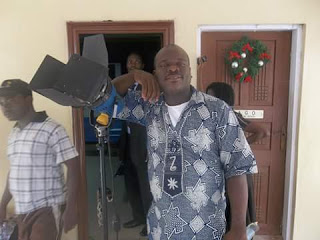Three-point lighting consists, as you might imagine, of three lights: the key, the fill
and the back. Together, these serve to wrap your subject in light, creating shadows that define the subject like a person’s face, but do not overpower it.
THE KEY
The key light is vital for video production lighting: it is placed about 45 degrees to the subject, either left or right, usually above and aimed down between 30 and
45-degrees. It is the dominant light. Position this light as you would if it were the only light you had.
From this, you’ll have defining shadows on the face which would be lost if the light were on a similar axis to the camera, but you’ll notice that, in a room with no other lighting, it will create deep, dark shadows. Toning down those shadows is the job of the next light.
THE FILL
The fill is usually two or three stops dimmer than the key light, and its placement is at a near 45-degree angle on the opposite side of the camera, often on a level with the subject’s face. The fill light is a reaction to the key light, and its ultimate placement depends on the function of the fill – what shadows does it create? Where do you need to reduce them for better video production lighting?
The fill light can be the same size as the key light in wattage and bulb size, but you might then place it further away than the key. Watch as the fill drives back the shadows; though the lighting is not nearly as harsh, these two together still present a very two-dimensional view.
The job of the third and final light is to create a sense of distance between the subject and the background, giving an illusion of a third dimension on the screen.
THE BACK LIGHT
The back light, sometimes called a rim or shoulder light, is aimed at the subject’s back, and, like the key light, it is usually 45-degrees off the axis and shines down upon the subject. This creates a bright rim around part of the subject, creating an outline which then appears to separate the shoulders from the background.
The back light should be at least as bright as the key, often brighter. Common Variations
Three-point lighting is a start – it’s a basic form from which many other types of video production lighting develop, and you shouldn’t be afraid to experiment with it. Here are some common variants of three point lighting.
Three-point lighting with only two lights: Very often you can use three-point lighting without having three physical lights – many times you might be able to use window light or direct sunlight as your key. Another common trick is to use a reflector instead of a fill light. Reflectors come in all shapes and sizes – large collapsible disks, a piece of foam core , a homemade construction of tin foil and cardboard or just someone with a white shirt simply standing near the subject to reflect some light back. Diffuse or not? While three-point lighting has been around for a long time, the type of diffusion to use with the lights doesn’t
seem to be universal. Often in film or video from the 70s and 80s, you’ll see bright lights with harsh shadows which attack our modern sensibilities and have us screaming “soft box!”
Putting the key and fill inside soft boxes or behind umbrellas is usually the thing to do. You can cover the rim light with a grid or snoot to keep the light focused specifically on the shoulder and back of the head and avoid spill. The key and the fill should be more diffused
than the rim.
What if I have a fourth light? The most common addition to three-point lighting is to add a fourth light to illuminate the background. This, along with the rim light, distances the subject from the background. Often you can use a standard three-point lighting kit and substitute a reflector for the fill light. Reflectors can be stand-mounted, or you can utilize existing architecture by positioning the subject where a white wall can act as the reflector. Bringing Them All Together As always, don’t practice this in the field when someone’s paid you $500 to do an interview of the Chairman of the Board for the year-end video. Practice at home, preferably on someone who’s fallen asleep in a chair in the middle of the room and won’t mind your blundering about for an hour or so.
It’s best to have some space between your subject and the background, not just so you can fit the back light and its stand in, but also to give some distance, usually in the form of an out-of-focus area that you create by a long lens and a wide f-stop. Ten to fifteen feet is optimal, but we don’t live in a perfect world and you take what
you can get.
Adjusting the three lights can be a bit tricky at first, and it’s beneficial to add them one at a time and observe how they affect one another. Add the key light first, and look at it both diffused (through an umbrella or even with just a diffuser in front of a barn door) and bare, then add the fill light. If you’re using a hot light rather than a reflector as a fill, you’ll also
be able to see how it looks diffused and bare. What happens to the key shadows
when the fill comes in? Can you describe the changes to the light?
Finally, add the back light. Try it from above aimed down, but also try it on the floor aimed up – what are the differences? Where Do I Get Lights? There are a number of places (many of
which you can find in the ads of this magazine) that sell “three-point lighting kits” that have three lights, a number of umbrellas, diffusers and carrying cases already assembled. The advantage of these is that they’re immediately useful; the disadvantage is that they might contain things you don’t really need and wouldn’t buy if you were getting your kit one piece at a time.
A good way to look at it is that your first lighting kit needn’t be your “forever” lighting kit; its job is to help you learn lighting; later, when you know what exactly your kit can’t do that you need it to, you can begin replacing parts of it.







